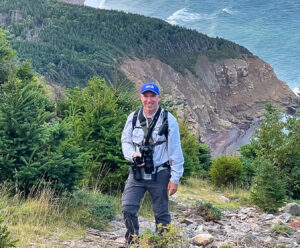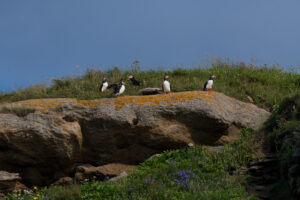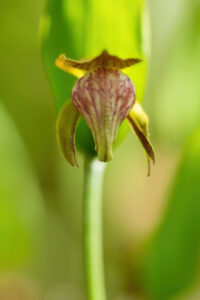Steven McGrath: Capturing Nova Scotia’s Wild Spaces
01 Apr 2025
One morning in the Baddeck area, Steven McGrath set out on a routine property survey, prepared for the usual sights of Cape Breton’s rugged wilderness. His work as a Wilderness Property Guardian for the Nova Scotia Nature Trust had taken him to many remote locations, each with its own stunning ecology. But that day was different.
As he climbed onto a plateau, the view opened to a stunning landscape of rolling hills and dense forest. He took a moment to appreciate the unique vantage point before pressing on. When he reached the backside of the plateau, he was greeted by an unexpected presence—a massive bull moose standing in a clearing.
“You’re always on the lookout, but I was not expecting to see it,” Steven recalls. “It wasn’t quite into the rutting season, so he wasn’t too worried, but I had seen scrapings on the trees and some tracks, so I knew one was around.” The moose, unfazed by Steven’s presence, remained in place as he watched for 10 to 15 minutes. He regretted not having his professional camera, but his phone captured what it could—though, as he puts it, “it just doesn’t do it justice.”
The morning’s encounter alone would have made the day memorable, but nature had more surprises in store. As Steven made his way down from the plateau, he heard movement in a nearby brook. Curious, he stepped closer and was delighted to see a family of otters—three playful young ones and an attentive adult—splashing around in the water.
“I think it was three babies and maybe the mother,” he says. “They were play fighting, mucking up the water while the adult looked for food. They knew I was there, but they didn’t pay me any attention.” Sitting just ten feet away on the bank, Steven observed the family for a while, appreciating a rare and intimate glimpse into their world.
Two chance encounters with wildlife in a single day would have been enough, but his survey led to yet another discovery—a plant he had never seen before. It turned out to be White Baneberry, a poisonous species known for its striking white berries.

For Steven, moments like these are a reminder of why he dedicates his time to conservation. Based in Sydney, Cape Breton, his journey into environmental stewardship began with an early passion for birding and wildlife photography. “I started off with an interest in birding, which led me to the Nova Scotia Bird Society,” he explains. Now a board member of the organization, his work naturally expanded to include broader conservation efforts.
His involvement with the Nova Scotia Nature Trust began through the Bird’s Eye View program, which introduced him to the organization’s mission and properties. Through his growing participation in conservation work, he discovered the Wilderness Property Guardian program—a perfect fit for his skills and interests. “I was already visiting properties for both the Nova Scotia Nature Trust and the Nature Conservancy of Canada, doing wildlife surveys,” he says. “So becoming a Wilderness Property Guardian just made sense.”
Now responsible for monitoring and maintaining multiple protected areas, including sites in Plaster Cliffs and Baddeck river, and the Rudy Haase Conservation Lands, Steven takes pride in ensuring these lands remain healthy habitats for diverse wildlife. His work includes surveying species, reporting environmental changes, and participating in conservation initiatives like the Mabou Highlands Blitz—a large-scale effort where volunteers survey multiple properties over a weekend.
“It was great because you get to meet other people doing the same thing,” he says. “It was a nice weekend.”
Steven has also been an active volunteer with Birds Canada, monitoring Piping Plovers along Cape Breton’s beaches. Recognizing that habitat loss is one of the greatest threats to wildlife, he believes that organizations like the Nova Scotia Nature Trust play a vital role in preserving these spaces.
“The biggest challenge many species face is habitat loss,” he emphasizes, which is why it is so important to be involved with the work the Nature Trust does to protect these essential environments.

A firm believer in citizen science, Steven regularly uses iNaturalist to document his observations. Initially focused on birds, his interest has expanded to include lichens, orchids, and other flora and fauna. “I’ve developed a big interest in species at risk, like Blue Felt Lichen,” he says. “Whenever I visit a Nature Trust or Nature Conservancy property, I log observations in iNaturalist. It helps provide accurate location data and assists with long-term monitoring.”
His latest goal? Documenting every orchid species in Nova Scotia, including rare and endangered varieties like the Ram’s-head Lady’s Slipper.

Steven finds his work deeply rewarding, whether it’s hiking through protected areas, discovering new plant species, or encountering wildlife in their natural habitat. He enjoys the challenge of navigating remote landscapes and takes pride in contributing to conservation efforts that protect vital ecosystems.
For him, every outing is an opportunity to learn something new. Having spent most of his life in Cape Breton, he still finds himself coming across species he’s never seen before. Whether he’s out monitoring trails, photographing wildlife, or logging observations, he knows that each effort plays a role in preserving the natural spaces he cares about. And if others are inspired to get outside and explore, all the better!
Learn more about our Wilderness Property Guardians and Bird’s Eye View volunteer programs! And thank you as always to East Coast Credit Union for their ongoing support of our volunteer programs.
